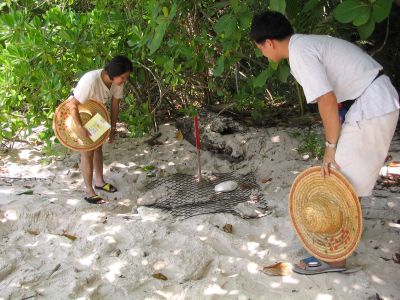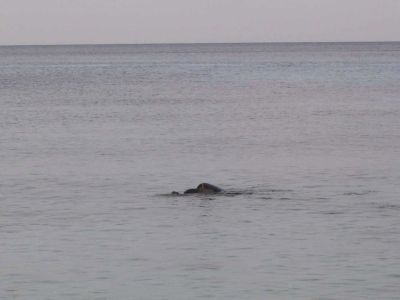We were volunteers at Chagar Hutang from 15-22 May 2005, 8D/7N.
Chagar Hutang is an isolated beach on the north of Pulau Redang. It is no ordinary beach because it is off limits to visitors except for staff and volunteers of the Sea Turtle Research Unit (SEATRU) of Kolej Universiti Sains dan Teknologi Malaysia (KUSTEM) (update: now Universiti Malaysia Terengganu) in Terengganu. It is one (and the 'busiest') of three turtle nesting beaches on Pulau Redang.
What did we do there? It's all about turtle conservation...
At night, we watched out for turtle landings and nestings. During our stay, 10 turtles landed and 5 of them nested. We assisted in the measuring of the size of the turtles, checking the turtles' tags, and noting the time of the turtles' nesting activities. We also observed markings on the turtles (if any).

[Turtle eggs: The green turtle lays about 100 eggs on average in each nest]
In the morning, we surveyed the new nests, i.e. measuring and marking the location of the nests and covering them with protective wire meshes.

[What's the distance? Fong Peng (one of SEATRU's research assistants) and Angie measuring the location of the nest]
During the day, we patrolled the beach to ensure the nests are not disturbed by monitor lizards or crabs. We also ensured that the beach remained off limits to human visitors.

[On our patrol: Halt! Who goes there?]
What else did we do? We snorkelled to our hearts' content, cleaned the beach, visited the Marine Park and the village, and hiked up Turtle Rock (a precariously perched rock on one of the hills surrounding the beach). There were lots of wildlife, too. We saw many turtles mating, monitor lizards, hermit crabs by the hundreds, squirrels, tree shrews, butterflies, flying fish, black-tipped sharks, a mousedeer, monkeys, gecko lizards and mosquitos... lots of them *itch*.

[Mating turtles taking a breath: Mr. Turtle appears to 'float' on the water while Mrs. Turtle's head just barely breaks the surface in front of her hubby]
Facilities at Chagar Hutang is basic but complete. No electricity (i.e. no TV, radio... ahhh... *bliss!*) and no handphone reception (*double bliss!*). There's piped stream water (i.e. we're bathing, cooking, doing the laundry and washing our *censored* with mineral water *kih, kih!*) and plenty of food (and lots of opportunity to learn new dishes).

[Our living quarters for the week viewed from the kangkung patch]
The stay was memorable and the experience was priceless. Do visit the SEATRU website for volunteer information and slot bookings.

[Turtle watchers: Staff and volunteers at Chagar Hutang, 15-22 May 2005]
Chagar Hutang is an isolated beach on the north of Pulau Redang. It is no ordinary beach because it is off limits to visitors except for staff and volunteers of the Sea Turtle Research Unit (SEATRU) of Kolej Universiti Sains dan Teknologi Malaysia (KUSTEM) (update: now Universiti Malaysia Terengganu) in Terengganu. It is one (and the 'busiest') of three turtle nesting beaches on Pulau Redang.
What did we do there? It's all about turtle conservation...
At night, we watched out for turtle landings and nestings. During our stay, 10 turtles landed and 5 of them nested. We assisted in the measuring of the size of the turtles, checking the turtles' tags, and noting the time of the turtles' nesting activities. We also observed markings on the turtles (if any).

[Turtle eggs: The green turtle lays about 100 eggs on average in each nest]
In the morning, we surveyed the new nests, i.e. measuring and marking the location of the nests and covering them with protective wire meshes.

[What's the distance? Fong Peng (one of SEATRU's research assistants) and Angie measuring the location of the nest]
During the day, we patrolled the beach to ensure the nests are not disturbed by monitor lizards or crabs. We also ensured that the beach remained off limits to human visitors.

[On our patrol: Halt! Who goes there?]
What else did we do? We snorkelled to our hearts' content, cleaned the beach, visited the Marine Park and the village, and hiked up Turtle Rock (a precariously perched rock on one of the hills surrounding the beach). There were lots of wildlife, too. We saw many turtles mating, monitor lizards, hermit crabs by the hundreds, squirrels, tree shrews, butterflies, flying fish, black-tipped sharks, a mousedeer, monkeys, gecko lizards and mosquitos... lots of them *itch*.

[Mating turtles taking a breath: Mr. Turtle appears to 'float' on the water while Mrs. Turtle's head just barely breaks the surface in front of her hubby]
Facilities at Chagar Hutang is basic but complete. No electricity (i.e. no TV, radio... ahhh... *bliss!*) and no handphone reception (*double bliss!*). There's piped stream water (i.e. we're bathing, cooking, doing the laundry and washing our *censored* with mineral water *kih, kih!*) and plenty of food (and lots of opportunity to learn new dishes).

[Our living quarters for the week viewed from the kangkung patch]
The stay was memorable and the experience was priceless. Do visit the SEATRU website for volunteer information and slot bookings.

[Turtle watchers: Staff and volunteers at Chagar Hutang, 15-22 May 2005]













